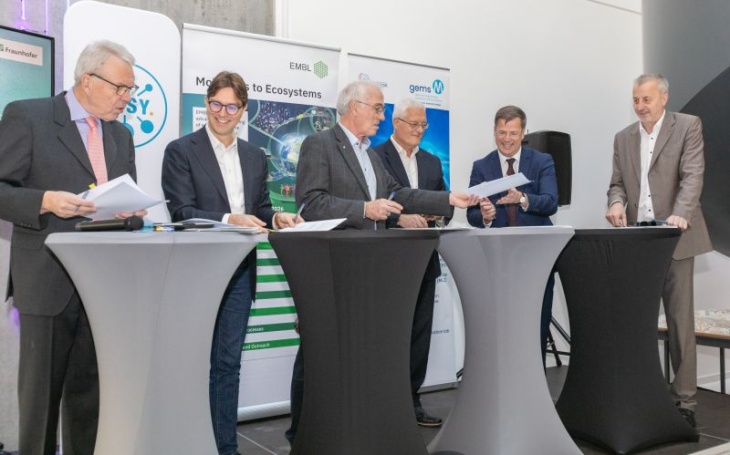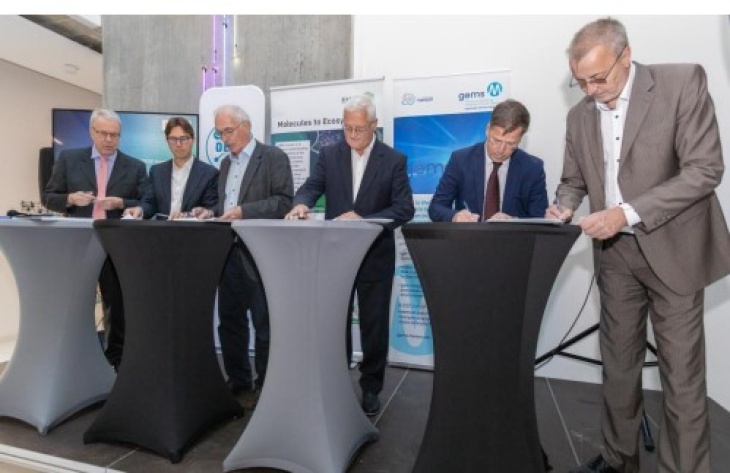Collaboration for the benefit of research and industry
Fraunhofer-Gesellschaft Press Release
A delegation from the Fraunhofer-Gesellschaft, the Deutsches Elektronen-Synchrotron (German Electron Synchrotron, DESY), the Helmholtz-Zentrum Hereon and the European Molecular Biology Laboratory (EMBL) signed a memorandum of understanding (MoU) in Hamburg. With this declaration of intent, the four research institutions have confirmed their plans to work together, pooling their respective expertise and infrastructure to create added value for research and industry.
From new imaging methods to new data formats and analyses and from screening of active agents to biomaterials: The potential that synchrotron radiation also holds for applied research is enormous. Fraunhofer, DESY, Hereon and EMBL have agreed on a strategic partnership to utilize this even more effectively in the future. The aim is to establish structured collaboration between the four research institutions in the near future. Particular emphasis will be placed on the use of the analytical infrastructure at the DESY campus in Hamburg, for instance the X-ray radiation source PETRA III but also the free electron lasers.
Cornerstone for greater efficiency and competitiveness

Strong partners with strong topics: Researchers from all four institutions will cooperate routinely [Photo: DESY/ Marta Mayer]
Prof Axel Müller-Groeling, executive vice president for Research Infrastructures and Digital Transformation at the Fraunhofer-Gesellschaft, explained: “By signing the memorandum of understanding, we are paving the way for an important contribution to greater efficiency and competitiveness of the German research landscape. In times of economic and social challenges, it is essential to pool expertise, infrastructure and knowledge across the boundaries of individual research institutions and to translate this into innovations in a planned and targeted manner. In doing so, not only will we be able to appeal to new customer groups in the future; we will also be able to address the pressing industry issues even more efficiently, shorten innovation cycles and boost our success.”
Dr Arik Willner, chief technology officer at DESY, described the collaboration as follows: “The step we have taken in entering this collaboration with an impressive number of Fraunhofer institutes as well as our partners Hereon and EMBL shows how relevant DESY’s analytical capabilities are, not only for basic research but also for industrial issues, making it highly relevant in terms of innovation.”
Prof. Matthias Rehahn, scientific director of the Helmholtz-Zentrum Hereon, explained: “For many years now, Hereon has been successfully operating instruments for materials science investigations at two of Europe’s most powerful synchrotron radiation and neutron sources (PETRA III and FRM II) under the GEMS (German Engineering Materials Science Centre) user platform and making them available to users from both academia and industry. By working more closely with the Fraunhofer community, we will be pooling Hereon’s expertise in the use of these systems with the experience that the Fraunhofer institutes have in industrial research.”
Prof Matthias Wilmanns, head of EMBL Hamburg, said: “We are very excited about the opportunity that this partnership will provide for us to expand our beamline services for industrial applications and the field of life sciences. We believe that the goals of the Fraunhofer-Gesellschaft, Hereon, DESY and EMBL are strongly aligned. Working closely with these research institutions will open new possibilities for us to implement the EMBL program ‘Molecules to Ecosystems,’ which involves researching the molecular basis of life in the context of changing environments. Our aim is to transform our understanding of life on earth and to provide information on potential solutions for some of society’s biggest challenges, such as irreversible loss of biodiversity, antimicrobial resistance, pollution, climate change, food security and emergent pathogens.”
Key questions of fundamental research

Signing of the »Memorandum of Understanding« [Photo: DESY / Marta Mayer]
The collaboration between the four partners is designed to address key issues relating to both basic and applied research with the aim of boosting the technological performance and competitiveness of research and industry. For example, the collaboration that Fraunhofer has agreed with DESY, Hereon and EMBL will allow bespoke access to X-ray-based analytics so that it can address issues of current industrial relevance with the highest level of informative value. DESY and its campus partners will, in turn, expand their analysis portfolio through in-house and joint projects and will utilize Fraunhofer’s extensive preparation and data evaluation portfolio. In addition, Fraunhofer will provide application-oriented issues that will form the basis for collaborative marketing of analytical methods and portfolios to the industrial sector.
Initially, a total of 25 Fraunhofer institutes will be collaborating with experts from DESY, Hereon and EMBL.
Deutsches Elektronen-Synchrotron DESY
The Deutsches Elektronen-Synchrotron (DESY) is a foundation. As a member of the Helmholtz Association of German Research Centers, the research center for accelerator technologies develops and operates some of the most powerful X-ray sources in the world. The center makes this large-scale equipment available to the global scientific community for both basic and applied research purposes.
European Molecular Biology Laboratory (EMBL)
The European Molecular Biology Laboratory (EMBL) is Europe’s research institution for life sciences. It coordinates bioscientific research throughout Europe in its capacity as a scientific pioneer. Its outstanding basic research strives for collaborative and interdisciplinary solutions to some of society’s greatest challenges. The EMBL also places emphasis on vocational training for students and researchers, the (further) development of new technologies and methods and the deployment of state-of-the-art research infrastructure with a wide range of experimental and data services.
The EMBL is an intergovernmental organization with 28 member states, one associate member and two aspiring members. At six locations in Barcelona, Grenoble, Hamburg, Heidelberg, Hinxton near Cambridge and Rome, it conducts research into life in its natural context, from molecules to ecosystems.
Fraunhofer-Gesellschaft
The Fraunhofer-Gesellschaft, based in Germany, is the world’s leading applied research organization. By prioritizing key technologies for the future and commercializing its findings in business and industry, it plays a major role in the innovation process. A trailblazer and trendsetter in innovative developments and research excellence, it is helping shape our society and our future. Founded in 1949, the Fraunhofer-Gesellschaft currently operates 76 institutes and research units throughout Germany. Around 30,800 employees, predominantly scientists and engineers, work with an annual research budget of roughly 3 billion Euro, 2.6 billion Euro of which is designated as contract research.
